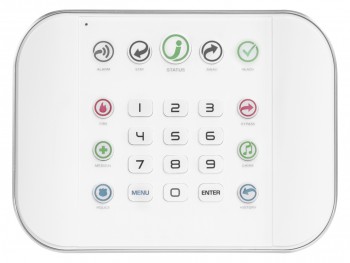Wrapper to XGen/XGen8/ComNav/Hills/Interlogix NX-595E/UltraSync ZeroWire
Project description
NX-595E Output Control Fork
This fork is designated to implementing the "Output Control" section of the NX-595E. The main objective is to enable communication with the outputs and ensure its proper implementation.
NX-595E UltraSync Hub
Compatible with both NX-595E Hills ComNav, xGen, xGen8 (such as NXG-8-Z-BO), Interlogix, and ZeroWire UltraSync solutions.
How Does It Work?
-
First you need to install it; this part is easy:
# Install ultrasync onto your system pip install ultrasync
-
Create a configuration file that identifies:
- The hostname or IP address of the ComNav/ZeroWire hub you've got setup on some the network.
- Your ComNav/ZeroWire login User ID.
- Your ComNav/ZeroWire login pin.
Note: You can only be logged into the ComNav/ZeroWire hub with the same user once; a subsequent login with the same user logs out the other. Since this tool/software actively polls and maintains a login session to your Hub, it can prevent you from being able to log into at the same time elsewhere (via it's website). It is strongly recommended that you create a second user account on your Hub dedicated to just this service.
# An example of what would be found in your configuration file: # Use hashtags/pound symbols (#) to optionally add comments # Syntax is simply <key>: <value> # # You must specify a ip/hostname, user, and pin # host: 192.168.0.30 user: My Username pin: 1234
-
Use the --scene (-s) to set your security system's alarm scene. The possible options are:
disarm,away, andstay.# By default if no --config= (-c) is specified, one will be automatically # loaded from the following location (if present): # ~/.ultrasync # ~/.config/ultrasync # Windows users can store their default configuration files here: # %APPDATA%/UltraSync/config # %LOCALAPPDATA%/UltraSync/config # Disarm your security system ultrasync --scene disarm # Arm your security system and activate all of your sensors when setting the # away mode macro ultrasync --scene away # Arm your security system and only activate your perimeter sensors: ultrasync --scene stay
What Else Can It Do?
-
You can put up a live monitor of your device by typing the following:
# A live monitoring of your home security system: ultrasync --watch
-
You can generate a snapshot (in JSON format) that greatly details everything taking place through your security home setup. It provides MUCH greater detail than the
--watchwhich allows it to also be integrated with Home Assistant.# Print a JSON formatted snapshot of all home security details ultrasync --details
-
You can perform a dump of all of the web based files (that I've found to be useful so far) to disk. This makes troubleshooting much easier.
# Extracts information from your UltraSync Hub that can be # incredibly useful in debugging and/or adding enhancements # later on: ultrasync --debug-dump
The debug content gets written to a zip file (residing in the same folder you ran this command from) in the form of:
YYYYmmddHHMMSS.ultrasync-dump.zip.
Reverse Proxy
If you've exposed your panel to the internet, you can access it by setting your host to the full URL to it (instead of just the hosthame/ip). For example:
# A sample UltraSync configuration that requires you to pass through
# a proxy in order to get to your destination:
host: https://your.security.panel/
user: My Username
pin: 1234
If you've also protected your panel behind an additional user/pass combo using Basic Auth at the reverse proxy level, you can pass through it like so:
# A sample ultrasync configuration that requires you to pass through
# a proxy expecting authentication in order to get to your destination:
host: https://user:pass@your.security.panel/
user: My Username
pin: 1234
# You can also optionally turn off the secure hostname verification
# by using the verify switch. But default this is set to yes if not
# specified:
verify: no
Global Variables
You can also (optionally) set the following global variables to provide the equivalent of what the configuration file could have. If a configuration file is also loaded, it's settings will always prevail. If an entry is missing, then the environment variable is used instead (if it's defined):
| Global Variable | Description |
|---|---|
| ULTRASYNC_PIN | Provides the pin variable to the library |
| ULTRASYNC_USER | Provides the user variable to the library |
| ULTRASYNC_HOST | Provides the host variable to the library |
| ULTRASYNC_SSL_VERIFY | Provides the verify variable to the library |
Disclaimer
This software was created by reverse engineering my own personal security system. All of this code was generated through trial and error since there is no documentation that I could find that explains the registers. If you can help out by filling in some of the blanks throughout the code base, I would be greatly appreciative of it! Alternatively buying me a coffee greatly inspires me to continue improving the application.
Project details
Release history Release notifications | RSS feed
Download files
Download the file for your platform. If you're not sure which to choose, learn more about installing packages.
Source Distribution
Built Distribution
File details
Details for the file ultrasync-1.0.1.tar.gz.
File metadata
- Download URL: ultrasync-1.0.1.tar.gz
- Upload date:
- Size: 81.7 kB
- Tags: Source
- Uploaded using Trusted Publishing? No
- Uploaded via: twine/6.1.0 CPython/3.13.2
File hashes
| Algorithm | Hash digest | |
|---|---|---|
| SHA256 |
d6514f237d1b04891b3543f3c09ffa6488f75e2218aae20a2231b75fb2596eac
|
|
| MD5 |
3ca831541b669f8f8d58ecabb8a335c0
|
|
| BLAKE2b-256 |
13f7fc6e478ef5fa9716ce45de250b17209c9adcb1cda18a3bdc8f33beaff578
|
File details
Details for the file ultrasync-1.0.1-py3-none-any.whl.
File metadata
- Download URL: ultrasync-1.0.1-py3-none-any.whl
- Upload date:
- Size: 30.3 kB
- Tags: Python 3
- Uploaded using Trusted Publishing? No
- Uploaded via: twine/6.1.0 CPython/3.13.2
File hashes
| Algorithm | Hash digest | |
|---|---|---|
| SHA256 |
eafbbd1c956e9425eca5a5078dfc292c1f9adcd61c86e6c1184928b3e3fd5e5b
|
|
| MD5 |
8ac8b2cd46c96a0243f2b206e957bb89
|
|
| BLAKE2b-256 |
e6389152b276cbbb4ab9406a849a97fef3cf307263f717e090e8aaf9c773ac92
|


















